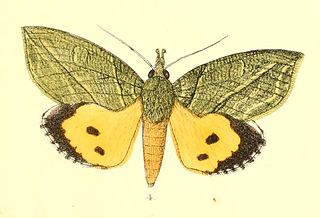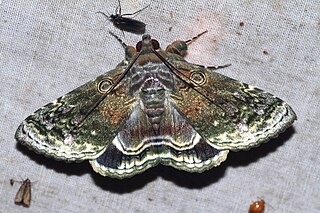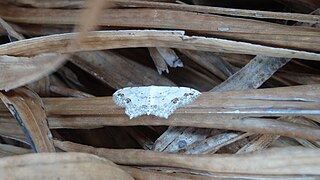
Eudocima hypermnestra is a moth of the family Erebidae described by Pieter Cramer in 1780. It is found in China, Thailand, Taiwan, India and Sri Lanka.

Chiasmia emersaria is a moth of the family Geometridae. The species was first described by Francis Walker in 1861. It is found in India, Nepal, northern Thailand, China, Sri Lanka, Japan and the Ryukyu Islands.

Eucyclodes gavissima, the Oriental orange banded green geometer moth, is a species of moth of the family Geometridae described by Francis Walker in 1861. It is found in the Indian subregion, Sri Lanka, Bhutan, western China, Taiwan, Vietnam, Sumatra and Borneo.

Ischyja manlia is a species of moth of the family Noctuidae first described by Pieter Cramer in 1776. It is found in the Indian subregion, Sri Lanka, Myanmar, Thailand, China, Okinawa, Sundaland, Sulawesi, Korea, the southern Moluccas, Australia (Queensland) and Palau. Adults pierce the skin of fruit to suck the juice.

Cyclodes omma is a moth of the family Noctuidae. It is found from the Oriental tropics to the Moluccas, including India, Nepal, Vietnam, Cambodia, Myanmar, Thailand, Malaysia, Java, Bali, Sumatra, Timor, Sri Lanka, Flores, Sulawesi, the Philippines, China and Taiwan.

Ecliptopera muscicolor is a moth of the family Geometridae. It was described by Frederic Moore in 1888. It is found in India, Sri Lanka and Taiwan.

Fascellina chromataria is a moth in the family Geometridae described by Francis Walker in 1860. It is found in Korea, Japan, Taiwan, China, India, Bhutan and Sri Lanka.
Scopula addictaria is a moth of the family Geometridae. It was described by Francis Walker in 1861. It is found in Sri Lanka.
Scopula adeptaria is a moth of the family Geometridae. It was described by Francis Walker in 1861. It is found in Sri Lanka, India, Taiwan, Hainan, southern Myanmar, Peninsular Malaysia, Borneo, the Philippines, Sumba and northern Australia.
Scopula ferruginea is a moth of the family Geometridae. It was described by George Hampson in 1893. It is endemic to Sri Lanka.
Scopula modesta is a moth of the family Geometridae. It is found in Sri Lanka and India.
Scopula pedilata is a moth of the family Geometridae. It is found in Sri Lanka.

Scopula pulchellata is a moth of the family Geometridae. It is found in the Indo-Australian tropics, from India, Sri Lanka to Taiwan and the Solomon Islands, as well as in Africa.

Eutelia geyeri is a moth of the family Noctuidae first described by Rudolf Felder and Alois Friedrich Rogenhofer in 1874. This species is found in India, Sri Lanka, China and Japan, as well as from Africa, where its presence had been reported from Lesotho and Seychelles.
Ziridava xylinaria, the indistinct carpet, is a moth in the family Geometridae. The species was first described by Francis Walker in 1863. It is found in Sri Lanka, India, Hong Kong and on Peninsular Malaysia, Borneo, Java and possibly the Philippines and Sulawesi.
Gymnoscelis deleta is a moth in the family Geometridae. It is found in India, Korea, Japan, Taiwan and probably in Sri Lanka according to Hampson.

Rhinoprora palpata is a moth in the family Geometridae. It is found in the Indian subregion, Sri Lanka and western China, as well as on Java, Borneo and Taiwan. The habitat consists of mountainous areas.

Eois grataria is a moth in the family Geometridae. It is found in the Indian subregion, Sri Lanka, Hong Kong, Sundaland and on Christmas Island.

Hypomecis separata is a species of moth of the family Geometridae. It was first described by Francis Walker in 1863. It is found in Sri Lanka, India, Java and Borneo.
Syllepte leucographalis is a moth in the family Crambidae. It was described by George Hampson in 1912. It is found in Indonesia (Bali).












